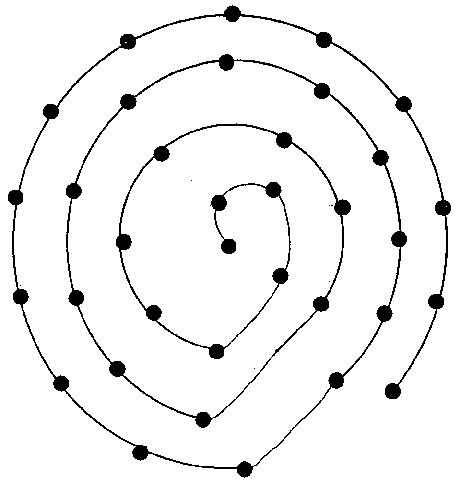by Lynne Manring
Jackstraws – Originally played with straws from a broom, this game is often known today as “Pick-up Sticks.” Use wooden skewers found in supermarkets or a commercial Jackstraw or Pick-up Sticks set (note: 19th C. players did not have colored sets where each color was worth a certain number of points). The first player spills the jackstraws on the ground so that they are spread out a bit. S/he then tries to pick up as many as possible, one by one, without making any other sticks move. If another stick moves, that player must stop and it becomes someone else’s turn. A stick that has been picked up successfully (without others moving) may be used as a helper. The winner is the player who has picked up the most sticks.
Hunt the Ring – Use a string or cord to make a circle large enough to accommodate a group of children. Place a ring on the string and then tie the ends together to make a large circle. Be sure the ring can move freely on the string. One child is chosen as “it” and stands in the center of the string circle. All the other children stand around the outside of the string circle, holding the string with two hands. “It” closes his/her eyes, and someone hides the ring in his/her hands and passes it, making sure the ring doesn’t show. Everyone else pretends to pass the ring as well, so that it is hard to tell who really has it. “It” then opens his/her eyes and tries to guess who has the ring. S/he gets three guesses and then changes places with the person who has the ring at that moment.
Graces – Each group of players needs a twelve-inch hoop, which may be decorated with ribbons. Each player needs a pair of sticks (quarter inch dowels work well) about 16-18 inches long. One player places the hoop on crossed dowels and sends it to the next payer by taking a step forward while quickly uncrossing the dowels with a forward and upward movement of the arms. The receiver catches the hoop on uncrossed dowels, then crosses them and tosses the hoop as described above. Two or more people can play this game. Players must try to maintain a graceful posture as they play.
Snail – [Historical Note: Sometimes children scratched the Snail pattern in the dirt with a stick. During the Revolutionary War, some soldiers made dice from soft lead musket balls, by flattening the sides of the balls and carving in the numbers with a knife. They would sometimes give these dice to children.]
This game uses dice, four different kinds of beans or small stones, and the playing board pictured below. The game is for two to four players. The goal of Snail is to be the first player to arrive at the center of the spiral on the playing board. Players take turns tossing a die. The person with the highest number goes first. If two people get the same number, roll again. The first player rolls the die and moves his/her marker (bean or stone) the number of spaces shown. If the player lands on a space with someone else’s marker, s/he must move back to the space from which s/he started. For example, if the player rolls a two and lands on someone else’s bean, s/he must move back two spaces. The play then rotates to other players. To win, a player must land in the center exactly. If, for example, a player is three spaces from the end and roles a four, s/he must skip a turn and try again on the next round.

